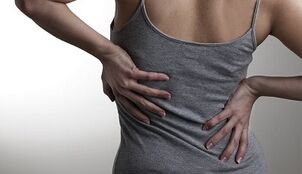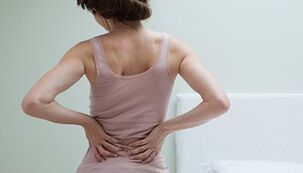
About 80 percent of adults have low back pain and if you also have problems, know that you are not alone. This can be corrected. The key is to understand the source of the pain, but there can be many factors. We have compiled the main causes of low back pain that can cause back problems. How to get better? There are roads.
Back pain can appear of any age and any condition. Therefore, there is dull, intermittent or intermittent pain, and there is a sudden, acute attack after which the patient has difficulty moving. The pain can come on suddenly due to heavy lifting, which can develop with age due to spinal changes or an accident. A sedentary lifestyle is also a significant cause of low back pain. Especially when daily routines are not diluted with physical activity (exercise, swimming, gymnastics, yoga).
In most cases, low back pain is acute and short term or less severe, but lasts from a few days to a few weeks. In such cases, a person remains without loss of activity, mobility, and self-service in everyday life.
Subacute pain is pain that is persistent after an acute episode and lasts 4 to 12 weeks. If the pain persists after this period, it is called chronic. Sometimes treatment can help get rid of chronic low back pain. But in some cases, the pain persisted even with medical and surgical treatment.
So back pain, a cause that is often age related and is related to wear and tear in the joints, disc and spine or mechanical pain:
1. Sprain
This can lead to serious back pain. Stretching occurs due to improper rotation or lifting of something. It could also be caused by heavy lifting or over stretching. These conditions can cause muscle spasms in the back, which also cause pain.
2. Wearing of the disc

One of the most common causes of back pain. This is manifested by the loss of integrity of the disc, and cracks appear. In a young and healthy back body, the discs allow the lower part to flex, not bend and twist. But over the years, the elasticity of the disc decreases, losing its ability to absorb shock.
3. Hernia
It may appear due to lifting a large load, wrong posture, accident, sports injury, etc. v. There is fluid in the center of the lumbar disc; For a variety of reasons, this fluid can drain out and stimulate nearby nerve roots. There are many nerve fibers in the wall of the disc, and tearing the wall can cause severe pain.
4. Radiation patient
This condition occurs due to compression, inflammation and / or damage to the spinal roots. Furthermore, the pressure on the nerve root leads to pain, numbness, or tingling sensation and spread to other parts of the body connected to that nerve. Problems can arise if the central spinal canal is narrowed or the hernia mass compresses the nerve root.
5. Sciatica
. This compression causes shock or burning pain in your lower back, associated with pain in the buttocks. And also in some special cases, when a nerve is squeezed between the disc and the neighboring bone, a person may experience severe numbness and weakness in the legs. By the way, this condition occurs because a tumor or cyst is pressing on the sciatic nerve or its roots.6. Spinal stenosis
In the case of this condition, in addition to lower back pain, the person may experience numbness or weakness in their legs while walking. And sensitivity may also be lost.
7. Scoliosis and other bone disorders

People do not usually have special problems with the curvature of their spine until middle age.
Low back pain is not usually associated with a serious medical condition. But you still need to be aware of their existence so that you can consult your doctor in time. It is possible to beat only the diseases listed below with the help of medical. This one:
1. Infection
This is not a cause of lower back pain, but can affect the spine (osteomyelitis), the disc (inflammation of the disc), or the sacroiliac joint (osteomyelitis).
2. Tumors
Sometimes a tumor appears in the back (and at certain stages there will be pain and other symptoms of course), but usually these are tumors that have metastasized by cancer in theanother part of the body.
3. Equina Cauda Syndrome
Diseases sometimes accompanied by broken disc. This is caused by disc material pressing into the spinal canal and squeezing the lumbar nerve root and sacrum. In connection with the disease, a person may experience urination and bowel problems.
4. Abdominal aortic aneurysm
This happens when a large blood vessel supplying blood to the abdomen, pelvis and legs is abnormally dilated. Additionally, lower back pain can be a signal that the aorta has enlarged and that there is a risk of rupture.
5. Kidney Stone
Rocks can cause severe pain in your lower back (usually on one side).
Other factors and causes of lower back pain:
- Arthritis Diseases.Examples include arthritis, spondylitis, spondylitis.
- Osteoporosis.This is a bone disease accompanied by a decrease in bone density and strength, which can lead to a spinal fracture.
- Endometriosis.A female illness can be accompanied by pain in the pelvis and lower back.
- Fibromyalgia.Pain syndrome, accompanied by muscle pain and fatigue. It is chronic.

What to do when you have back pain?
First of all, you need to have a good understanding of the cause of the pain. What can help one disease will not make (and possibly even worsen) another. And in some cases, urgent hospitalization is required. That is why be sure to listen to your body's signals and, if necessary, consult your doctor or take appropriate measures.
Ways to deal with low back pain:
1. You can rest after a certain amount of time
Many back problems can be resolved (or alleviated) by avoiding strenuous activities. However, do not rest for more than a few days, as not being inactive for too long can make treatment difficult.
2. Limited operation
This means staying active but avoiding actions and attitudes that increase pain. For example, if sitting in a car or at a desk for long periods of time aggravates pain, schedule a time to wake up every 20 minutes and walk or stretch gently. Minimizing actions and positions that aggravate pain will help prevent or alleviate the pain of cramping and speed up the healing process.
3. Cold / hot therapy
Take a warm bath, use hot compresses, and wrap the body appropriately to relax tense muscles and improve blood flow. If your back pain is caused by inflammation, you can try an ice pack or a cold compress to reduce swelling. It is important to protect the skin during the procedure to prevent tissue damage.
4. Pain reliever
The most popular over-the-counter drug is an anti-inflammatory that relieves back pain caused by swelling of nerves or muscles. And also in some cases, pain relievers can help. Vitamins B, muscle relaxants, various gels and ointments are effective.
5. Physiotherapy
Usually part of low back pain treatments. Stretching is very helpful: the more muscles move, the better your back can move without getting hurt. Start small - stretch your lower back, buttocks, thighs, and legs for 20-30 seconds and stop if you feel pain.
You will also need to strengthen the muscles in your abdomen, thighs, and butt to support your spine. Low-impact aerobic exercise increases blood flow and promotes injury healing without a spinal shock. For example, you can exercise on stationary bikes and ellipticals, walk and swim.
In fact, any exercise that keeps the heart cycle healthy in the long term is beneficial for the body. Regular physical activity is essential to maintaining the freedom of movement and flexibility of a healthy spine.












































